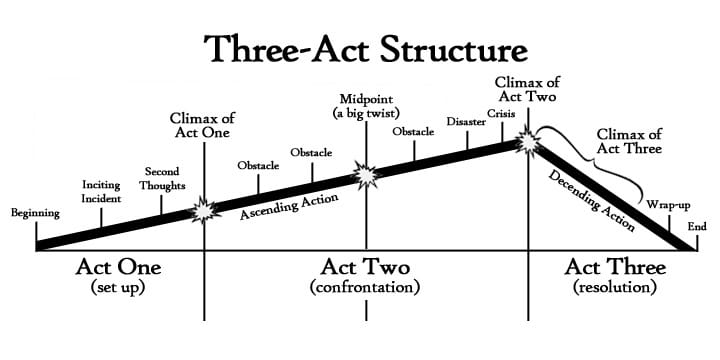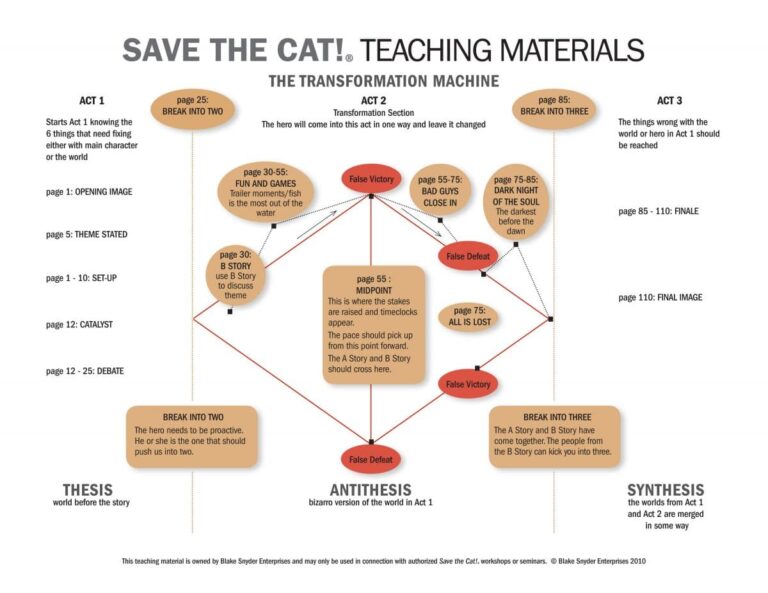The Setup: Consider the plot formula. The tired practice of reducing a story to its most basic elements, repackaging them, and stacking them together in the predictable pattern. The Hero with 1,000 Faces is called to an adventure in the first act; beaten because of her tragic flaw only to learn that it is the very thing that makes her strong in the second act; and able to overcome the villain, the elements, herself, or all three in the finale.

Every movie ever, basically.
The Catalyst: It can be contrived. It can be stodgy. It can be… a truly great thing.
Plot formulas are simply story tools that writers from all walks — novelists, screenwriters, copywriters, essayists, marketers — can use effectively, despite what people may say or think about them.

If only there was some visual metaphor that could succinctly sum up how a plot formula could cut to the quick of a story, and the debate over its usage…
The Debate: Sure, there are plenty of bad, formulaic movies out there. Think Transformers: Revenge of the Fallen, The Last Airbender, or any of the Star Wars prequels, really. It’s even arguable that screenwriters, producers, and directors have beaten audiences bloody with blunt plot formulas in a grab for their wallets.
But plot formulas have been used to make art that’s inspiring and evocative, too. Great films like Eternal Sunshine of the Spotless Mind, The Dark Knight, or any Pixar movie ever, really, all use plot formulas.
The reason plot formulas matter is because they can be used to tell great stories, and isn’t that what marketing’s all about?

Just try telling him his movie was bad because it was formulaic.
Fun & Games: There are scores of plot formulas out there. There’s the Three-Act Structure touted by story-gurus like Robert McKee or Syd Field, the Hero’s Journey formula of comparative mythologist Joseph Campbell, the Five Paragraph Essay your elementary school teacher impressed upon you, the Inverted Pyramid your journalism professor in college taught you, but the one plot formula to rule them all — the one most commonly used nowadays — is Blake Snyder’s Beat Sheet, also known as the BS2.
According to Snyder’s most famous book, Save the Cat!: The Last Book on Screenwriting You’ll Ever Need, every “good” movie has 15 different parts that occur at hyper-specific points of the screenplay. In a 110-minute long movie, Snyder literally figured out which key moments should occur and when.
While Snyder exclusively focused on screenwriting, there’s no reason marketers can’t apply his rhetorical patterns and composition theory to content marketing.
Just as Snyder argues, content should be first set up. The conflict/problem should be introduced, alongside the thematic statement/thesis. The issue is then discussed for a little, before being properly addressed. Disadvantages, cons, and downsides are then considered . The counter-argument. The against. Then, when the argument seems all but lost , the thesis is reintroduced as the solution to all of the problems that were just previously outlined, and the content resolves with a call to action. Just take a look at what movie critic Peter Suderman did in a piece for Slate.
Simple.

I swear it’s not as complicated as it looks.
Content marketers are already using plot formulas, too. Take a look at BuzzFeed, or Upworthy.
BuzzFeed posts thinly-veiled advertorial listicles to great effect. Here’s a quick example. At the top, you can see the sponsor, which in this case is IndeedAU. The title clearly explains what the content offers, “8 Successful People Talk About The Start of Their Career.” It then jumps right in with eight large quotes from successful people in various industries about getting started on a career, and ends with a clear call to action: “Find your turning point by searching the 16 million open positions on Indeed.”
As for Upworthy, one needs only take a look at the site’s attention grabbing headlines, which formulaically pique readers’ interests with a conflict, and then drag them into the story by following it up with some a statement that raises the stakes. For example, 2,000 Were Killed. Hundreds Are Missing. But We Stay Quiet or A Famous Athlete Tattooed 50 Names on His Body For a Sad Reason. Showing Them Got Him Suspended. See? the first sentence grabs your attention, and then the second immediately raises the stakes so that you just have to know what happened next.
Even Whether You’re Julia Child or the King of Ordering Takeout, You Need These Food Tips uses the formula.

Go on. Click the clickbait. You know you want to.
Bad Guys Close In: What’s the point of doing that, though? If you use the same formula over and over and over again, wouldn’t you produce the same content over and over and over again? Wouldn’t people stop reading that and Google start penalizing websites?
It’s true. Just take a look at how the current box office lineup is being rated on Rotten Tomatoes. Seven out of 10 of the highest grossing movies in the box office have ratings lower than 40%, which means that just about two-thirds of all critics gave the films bad write-ups. Of those seven movies, four had ratings lower than 20%.
Not to mention the fact that Google recently came out with an update this past summer to start penalizing sites that click-baited, or that use formulaic anchor text to bring more web traffic to low-quality content. Basically, they started cracking down on the type of headlines Upworthy employs to great effect.
It’s even being culturally shamed. Last year, the Onion launched a sister-site, Clickhole, parodying these sites that use formulaic content.

Batman gets it.
Dark Night of the Soul: So if using formulas is already having a negative impact, why continue? Why not do something different? Something innovative?
The Reward: Because you need to know the rules in order to break them.
Humans are creatures of habit, and they’re used to the certain patterns, certain storytelling conventions. Blake Snyder didn’t invent those natural laws, he just made notes, had some observations, and made insights into storytelling, which allowed him to write better. As Stephanie Palmer, a former MGM studio executive, writes, “Save the Cat is just another way of looking at the same underlying story structure that the psychologist Carl Jung would say is in everyone’s unconscious, that Campbell would say is in every culture’s stories, that Field and McKee described in a less formulaic, more intellectual way.”

“Plot formulas are super neat and helpful!” — Brett Rambo.
However, using a formulaic approach to content is not without its downsides. As Suderman explains, “I could see the advantages of the beat sheet. It helped me order my thoughts and figure out what I should say next. But I also found myself writing to fit the needs of the formula rather than the good of the essay—some sections were cut short, others deleted entirely, and other bits included mostly to hit the beat sheet’s marks. It made writing easier, in other words, but it also made me less creative.”
Finale: Quality content becomes more and more important with each Google update. Instead of trying to stuff keywords and build links, content marketers need to focus on simply building a better Internet, which means creating better content, a goal that plot formulas can help accomplish.